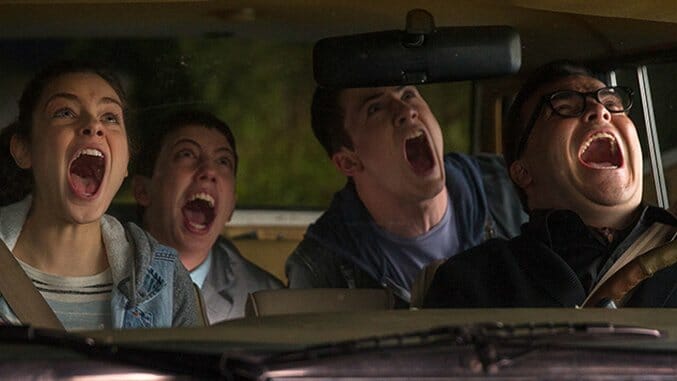Goosebumps

Rob Letterman’s Goosebumps is an amiable family matinee that comes so close to being something more that I walked out slightly disappointed in spite of the fact that I thoroughly enjoyed myself for a great deal of its running time. A riff on R.L. Stine’s enormously popular series of children’s horror stories, at its best it’s a kids’ movie like Joe Dante’s Explorers or some of the better Pixar entries. While many filmmakers in recent years seem to be motivated by their love of the ’80s, Goosebumps is the first film I’ve seen that actually recreates the charm of something like The Goonies or (again, from Dante) Gremlins and successfully updates it rather than merely imitating it.
The best storytelling in the movie, most of which comes in the first 30 minutes, likely stems from the contributions of screenwriters Larry Karaszewski and Scott Alexander, who are responsible for three of the greatest American screenplays of the last half-century, all of them unconventional biopics: The People Vs. Larry Flynt, Man on the Moon, and the singular Ed Wood. For Goosebumps, they’ve come up with a clever premise that enables them to use as many of R.L. Stine’s monsters as possible: In a sort of family-friendly take on Adaptation, Stine himself (Jack Black) is a character. Our hero, teenager Zach (Dylan Minnette), has moved in next door to a cute girl (Odeya Rush), whose dad is the famous kids’ horror author R.L. Stine. Stine’s secret is that his imagination has made the monsters he writes about real, and when Zach inadvertently lets some of them loose from Stine’s house, the author and the kids have to save their town from destruction.
Goosebumps takes more time establishing its characters than many fantasy films of its type, and this is where it earns comparison with Dante’s work. Zach and his would-be love interest Hannah have a lovely, easy rapport with each other, particularly in a date to an old amusement park that’s no longer operational. Letterman and the writers take real care crafting the teen romance step-by-step, in a manner that feels honest, plausible—while the rest of the film is larger than life. But once the monsters get loose, Goosebumps switches to autopilot. What follows is a series of mechanical set pieces in which the actors stop interacting with each other and face off against computer-generated creatures who barely even seem to be in the same room—sometimes even in the same movie.
-

-

-

-

-

-

-

-

-

-

-

-

-

-

-

-

-

-

-

-

-

-

-

-

-

-

-

-

-

-

-

-

-

-

-

-

-

-

-

-








































